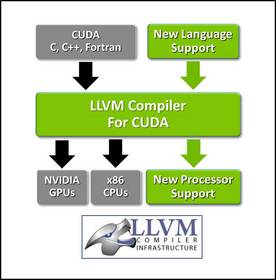SANTA CLARA, CA--(Marketwire - May 9, 2012) - NVIDIA today announced that LLVM, one of the industry's most popular open source compilers, now supports NVIDIA GPUs, dramatically expanding the range of researchers, independent software vendors (ISVs) and programming languages that can take advantage of the benefits of GPU acceleration.
LLVM is a widely used open source compiler infrastructure, with a modular design that makes it easy to add support for programming languages and processor architectures. The CUDA® compiler provides C, C++ and Fortran support for accelerating application using the massively parallel NVIDIA® GPUs. NVIDIA has worked with LLVM developers to provide the CUDA compiler source code changes to the LLVM core and parallel thread execution backend. As a result, programmers can develop applications for GPU accelerators using a broader selection of programming languages, making GPU computing more accessible and pervasive than ever before.
LLVM supports a wide range of programming languages and front ends, including C/C++, Objective-C, Fortran, Ada, Haskell, Java bytecode, Python, Ruby, ActionScript, GLSL and Rust. It is also the compiler infrastructure NVIDIA uses for its CUDA C/C++ architecture, and it has been widely adopted by leading companies such as Apple, AMD and Adobe.
"Double Negative has ported their fluid dynamics solver over to use their domain-specific language, Jet, which is based on LLVM," said Dan Bailey, researcher at Double Negative and contributor to the LLVM project. "In addition to the existing architectures supported, the new open-source LLVM compiler from NVIDIA has allowed them to effortlessly compile highly optimized code for NVIDIA GPU architectures to massively speed up the computation of simulations used in film visual effects."
"MathWorks uses elements of the LLVM toolchain to add GPU support to the MATLAB language," said Silvina Grad-Freilich, senior manager, parallel computing marketing, MathWorks. "The GPU support with the open source LLVM compiler is valuable for the technical community we serve."
"The code we provided to LLVM is based on proven, mainstream CUDA products, giving programmers the assurance of reliability and full compatibility with the hundreds of millions of NVIDIA GPUs installed in PCs and servers today," said Ian Buck general manager of GPU computing software at NVIDIA. "This is truly a game-changing milestone for GPU computing, giving researchers and programmers an incredible amount of flexibility and choice in programming languages and hardware architectures for their next-generation applications."
To download the latest version of the LLVM compiler with NVIDIA GPU support, visit the LLVM site.
To learn more about GPU computing, visit the NVIDIA website. To learn more about CUDA or download the latest version, visit the CUDA website. More NVIDIA news, company and product information, videos, images and other information is available at the NVIDIA newsroom.
About NVIDIA
NVIDIA (
Certain statements in this press release including, but not limited to statements as to: the impact and benefits of NVIDIA GPUs; and the effects of the company's patents on modern computing are forward-looking statements that are subject to risks and uncertainties that could cause results to be materially different than expectations. Important factors that could cause actual results to differ materially include: global economic conditions; our reliance on third parties to manufacture, assemble, package and test our products; the impact of technological development and competition; development of new products and technologies or enhancements to our existing product and technologies; market acceptance of our products or our partners products; design, manufacturing or software defects; changes in consumer preferences or demands; changes in industry standards and interfaces; unexpected loss of performance of our products or technologies when integrated into systems; as well as other factors detailed from time to time in the reports NVIDIA files with the Securities and Exchange Commission, or SEC, including its Form 10-K for the fiscal period ended January 29, 2012. Copies of reports filed with the SEC are posted on the company's website and are available from NVIDIA without charge. These forward-looking statements are not guarantees of future performance and speak only as of the date hereof, and, except as required by law, NVIDIA disclaims any obligation to update these forward-looking statements to reflect future events or circumstances.
© 2012 NVIDIA Corporation. All rights reserved. NVIDIA, the NVIDIA logo and CUDA are trademarks and/or registered trademarks of NVIDIA Corporation in the U.S. and other countries. Other company and product names may be trademarks of the respective companies with which they are associated. Features, pricing, availability, and specifications are subject to change without notice.
